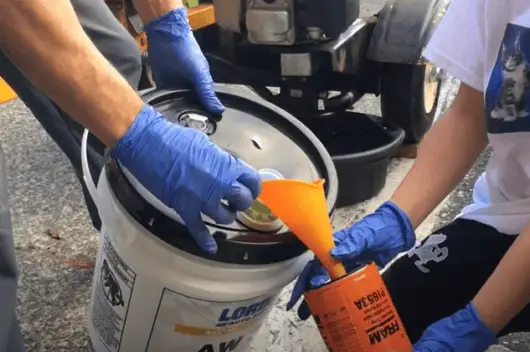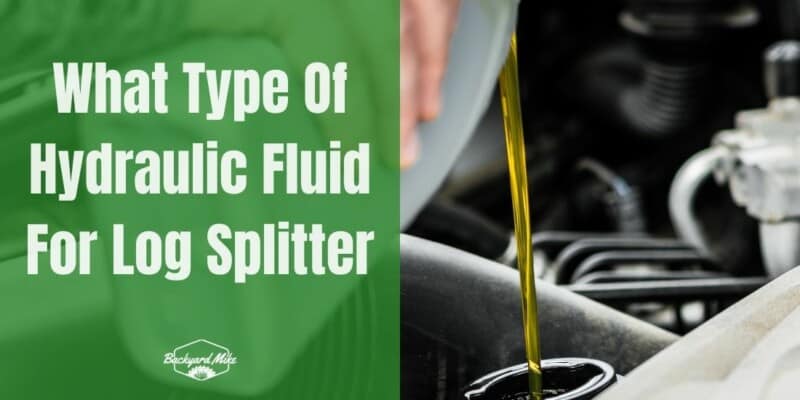At the center of every hydraulic log splitter, there is a hydraulic system powered by hydraulic fluid. Like any hydraulic system, a hydraulic log splitter works by applying pressure to a contained fluid to create power and force that pushes the log to the blade.
This applies to both gas-powered and electric hydraulic splitters. Kinetic log splitters use kinetic energy instead of a hydraulic system. This means you must give close attention to the fluid levels and feed it the appropriate hydraulic oil for a smooth operation. For that reason, you must understand the type of hydraulic fluid in your log splitter.
This article covers everything you should know about hydraulic fluids for log splitters.
Let’s get into it.
What is a hydraulic fluid?
A hydraulic system uses hydraulic liquid or fluid to transmit power. Hydraulic fluids are made of about 99% base stock and 1% additives. The fluid also acts as a lubricant, prevents corrosion, and reduces friction.
ALSO READ: Best Log Splitter on the Market
In a log splitter, the hydraulic fluid is held in a tank. When a log splitter is turned on, it powers the hydraulic pump that creates pressure inside the hydraulic system. The user then uses a valve to direct the fluid into the hydraulic cylinder that pushes the log.
How much hydraulic fluid is in a log splitter?
When you buy a hydraulic log splitter, it does have hydraulic fluid. So the first thing you should do is to add the fluid. Some brands add hydraulic fluid to the package, while others sell the fluid separately.
Log splitters hold between 3.5 up to 7 gallons based on the size and power of the splitter, but it’s recommendable you check in with your manufacturer and your model’s guidebook. Please note; Do not ever operate a splitter without the proper amount of fluid in the tank. Operating the machine without the recommended amount can damage the pump.
Never mix various types of oils. Use the one suggested by the manufacturer. If you’re unsure of the fluid already in your tank, the right approach is to drain the installed fluid and refill it with the recommended type.
What hydraulic oil to use in a log splitter?
The best hydraulic oil for your log splitter is what the manufacturer recommends in the manual. For most log splitters, the most recommended type of fluid is the AW32 or 32 hydraulic fluid. This type of hydraulic fluid covers the gears and other mechanic components in extreme heat or cold conditions. An alternative would be automatic transmission fluid, which should only be used as a substitute if the temperatures are under 32 degrees F.
When to change the fluid depends on the manufacturer’s recommendation. Most brands recommend changing the fluid after every 100 to 150 hours of splitting.
How to add hydraulic fluid to the log splitter

Position a funnel onto the tube, add the required fluid amount, and check the oil level using a dipstick. Be sure not to overfill. Remove and ground the spark wire against the engine. Next, pull the starter rope around 10 – 15 times.
It allows the pump to route the oil into specified system areas. The reservoir level should go down; you should confirm to re-check and load it up to the required level. In addition to this, not all splitters are the same; there’s a certain amount of fluid each splitter can accommodate. It would help to refer to the splitters manual to determine the amount of fluid to add.
Read more about how to add hydraulic fluid to the log splitter here!
How to change the hydraulic fluid in a log splitter
- When adding fluid to a splitter, the first thing should be draining all the fluid in the tank. Position a container below the oil reservoir to gather the oil. I suggest placing a sheet, or some sought of cardboard below the container. Nothing irritates more than an oil-stained floor.
- Second, remove the suction tube from beneath the fluid reservoir tank. Check your guidebook that came with the splitter.
- Please take out the intel filter carefully and wash it.
- Next, screw out the drain plug and let the oil drain into the proper vessel. A reservoir tank for a hydraulic log splitter can carry at least 3 gallons, and the whole system can carry up to 4.7 gallons.
- Now, the vital step; adding the oil into the splitter. Position a funnel on top of the fill tube, then add the required amount of fluid in the tank. Do not overfill; use a dipstick to check the fluid level.
- If called for, you can replace the filter and dipstick. Re-install the filter and dipstick. Screw up the fill pipe and also the drain plug.
- To assist in removing the air trapped in the system, use a control handle to hold the wedge and shift it side by side several times.
And that’s how to change hydraulic fluid in a log splitter.
Wrapping it Up
If you own a gas-powered or electric hydraulic log splitter, you should pay close attention to the hydraulic oil levels. Ensure you use the fluid suggested by the manufacturer to keep your log splitter in perfect shape.
FAQ
What is hydraulic fluid?
Hydraulic fluid is a non-compressible fluid used to move power in the hydraulic splitter. Also known as hydraulic liquid, it can be synthetic or mineral-based.
Why is my splitter working slowly?
There might be less hydraulic fluid in your system, or maybe the pump has a problem. You can look into the splitter’s manual for any specified troubleshooting guidelines.
Why is my splitter not starting?
There might be two possibilities to this problem: the tank might be empty, or maybe the engine is flooded. Turn to the troubleshooting part of the owner’s manual that came with the machine to be sure where the problem is.
Which is the ideal oil for my log splitter?
The ideal hydraulic fluid for your log splitter is what the manufacturer recommends.
The most recommended oil for log splitters is AW22 or 32. But different splitters can come with various fluids to use, so you should consult your manual to check the suggested fluid.


